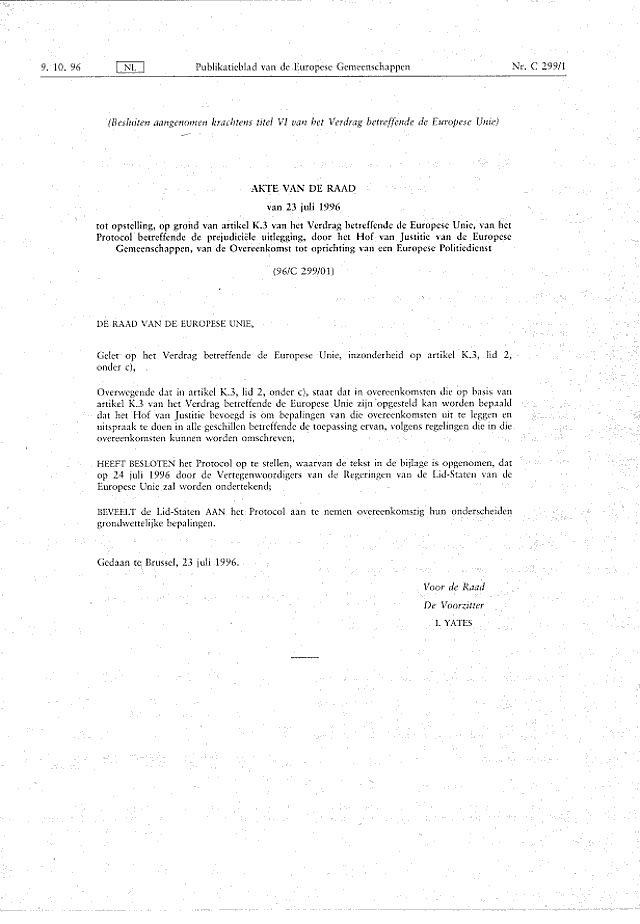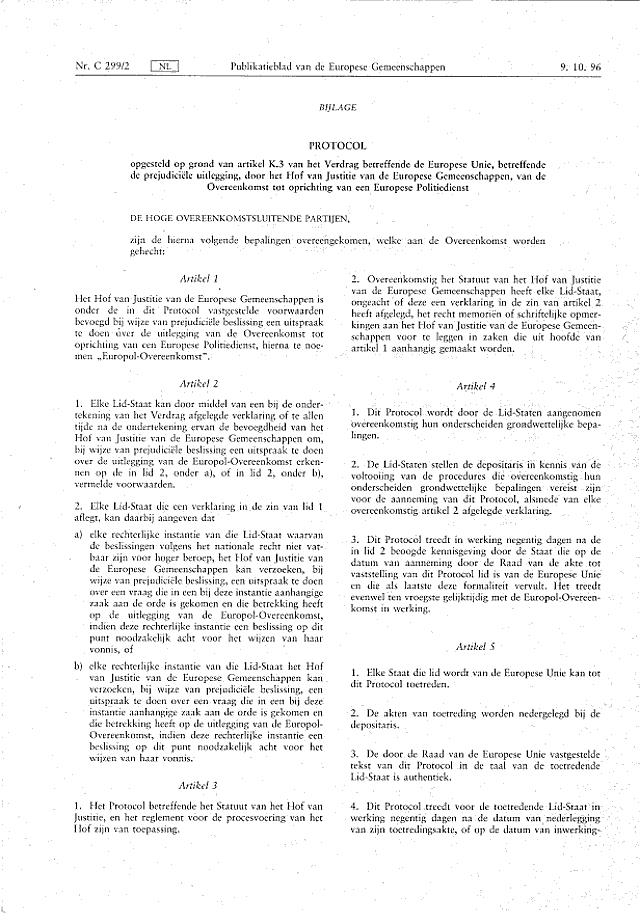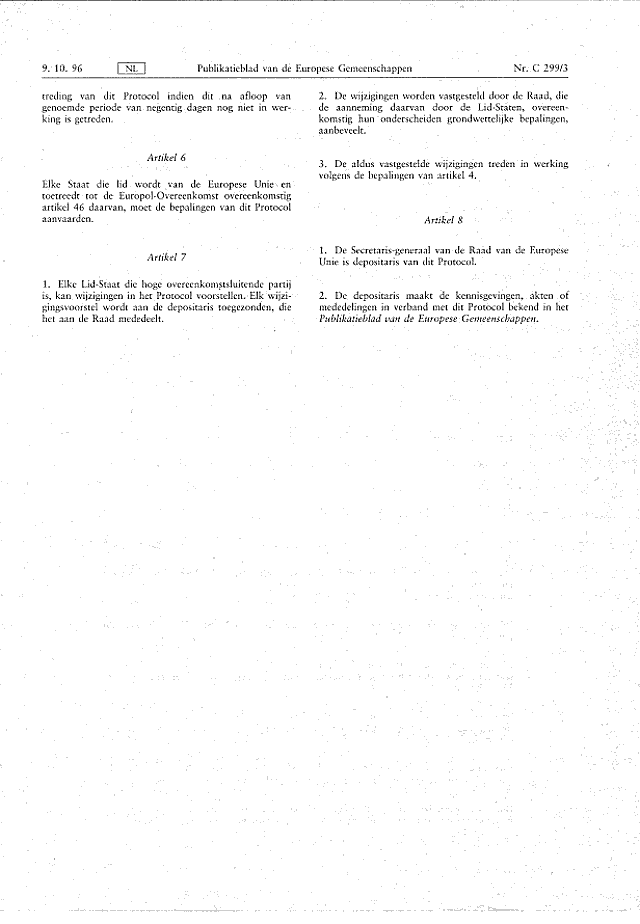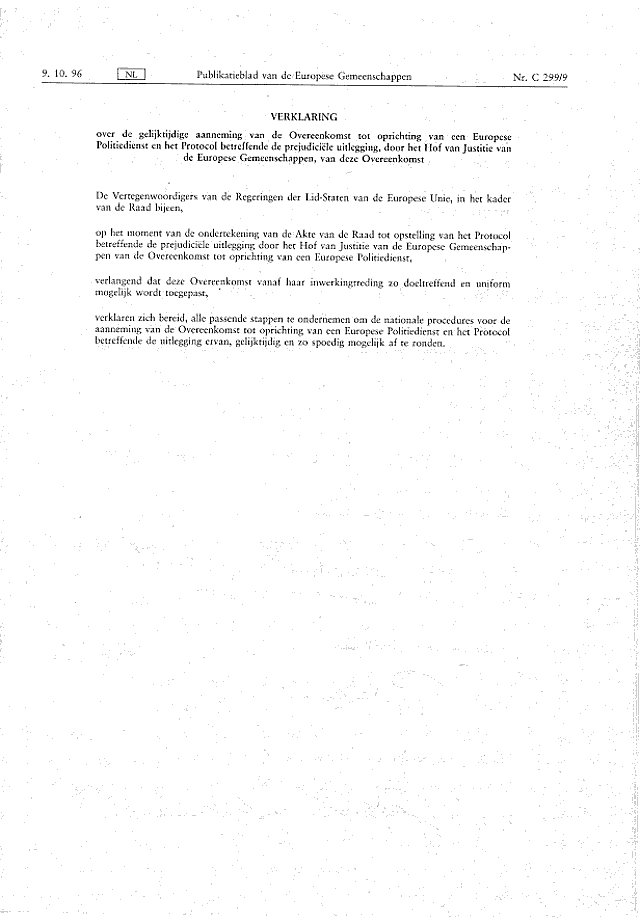
SAMENWERKINGSPROTOCOL tussen:
De REGIOPOLITIE ROTTERDAM-RIJNMOND
en
De BINNENLANDSE VEILIGHEIDSDIENST
1. Inleiding
Het verschaffen van veiligheid is van ouds een van de kerntaken van de overheid.
De burgemeester en het Openbaar Ministerie zijn verantwoordelijk voor de meest directe vormen van veiligheidszorg: het handhaven van de openbare orde en het vervolgen van strafbare feiten. Beiden voeren het gezag over de politie voor zover het handelen van de politie hun specifieke verantwoordelijkheid betreft. De politie is belast met de feitelijke uitvoeringstaken.
De Nederlandse politie maakt de afgelopen jaren steeds vaker gebruik van spyware van commerciële bedrijven om laptops, computers, smartphones en andere gegevensdragers van verdachten binnen te dringen. Volgens de wet mag de politie alleen gebruik maken van haar hackbevoegdheid bij verdenkingen van terrorisme en ernstige criminaliteit. Door middel van spyware verkregen gegevens worden echter nauwelijks tot niet gebruikt als bewijs bij rechtszaken.
Volgens de overheid vindt een screening van de leveranciers van spyware plaats. In de praktijk is van een screening echter geen sprake. De politie vertrouwt volledig op de verklaringen van bedrijven dat zij niet leveren aan dubieuze regimes, maar doet geen eigen onderzoek. Producenten van spyware leveren ook aan repressieve regimes waar spyware wordt ingezet tegen journalisten, mensenrechtenactivisten en oppositieleden. Ook bedrijven waarvan Nederland spyware heeft afgenomen, zoals Gamma Group en de NSO Group.
Voor dit profiel zijn mediaberichtgeving, rapporten van databeschermingsautoriteiten en andere openbare bronnen geraadpleegd. Ook zijn er informatieverzoeken gedaan bij de Nederlandse overheid.
De Nederlandse overheid heeft tot nu toe geen openheid van zaken gegeven over de inzet van DigiTask. Woo-verzoeken van Buro Jansen & Janssen blijven deels onbeantwoord, openbaar gemaakte documenten zijn grotendeels onleesbaar gemaakt. lees meer
Het Zuid Afrikaanse VASTech raakte in 2011 in opspraak na onthullingen over de levering van surveillance apparatuur aan het Libië van al-Qadhafi. Het leidde niet tot nader onderzoek of vervolging vanwege mogelijke betrokkenheid bij mensenrechtenschendingen.
Dit was niet de eerste keer dat VASTech surveillance apparatuur verkocht aan een repressief regime. Het bedrijf leverde aan het Zimbabwe van Mugabe en het Egypte van Moebarak. VASTech was sinds 2002 actief in Syrië en was in 2008 het enige bedrijf dat een voorstel kon indienen voor ‘monitoring equipment for international exchange’. In 2008 werd het Ministerie van Binnenlandse Zaken van de Verenigde Arabische Emiraten voorzien van een ‘mass monitoring system’.
Het Zuid-Afrikaanse bedrijf bleef na de onthullingen over Libië leveren aan repressieve regimes. Vanaf 2018 werkte het aan een monitoring centrum voor Saoedi-Arabië, dat in 2021 werd opgeleverd. Ook verkocht het bedrijf apparatuur aan onder meer Mexico, Pakistan en Georgië.
It was almost 10 p.m. on a Thursday night, and Ali Watkins was walking around the capital following instructions texted by a stranger. One message instructed her to walk through an abandoned parking lot near Washington, D.C.’s Dupont Circle, and then wait at a laundromat. Then came a final cryptic instruction: She was to enter an unmarked door on Connecticut Avenue leading to a hidden bar.
The Sheppard, an upscale speakeasy, was so dimly lit it was sometimes hard to see the menu, let alone a stranger at the bar. But amid the red velvet upholstery, Watkins, then a reporter at Politico, almost immediately spotted the man she was supposed to meet: He was wearing a corduroy blazer and jeans and had a distinctive gap between his teeth.
Dupont op justitie en veiligheid
Vorige week begonnen wij met een actie om zoveel mogelijk mails en brieven te versturen naar enige militaire bonden, het Veteranen Instituut en de Commandant der Strijdkrachten R.P. Bauer.
Deze actie is niet beëindigd en gaat gewoon door. Er zijn verschillende redenen voor deze actie: Door grote aantallen mails en brieven wordt er druk uitgeoefend op de geadresseerden. Niemand kan er meer omheen of roepen dat ze het niet wisten. Er is een PR-probleem bij Defensie door zoveel kritieke vragen en opmerkingen. Door de actie wordt tevens duidelijk wie er achter de veteranen staan en wie niet.
Dupont op justitie en veiligheid
Nu er een waar offensief lijkt gestart tegen Staatsbosbeheer (SBB), kan SBB niet anders dan reageren. Zij doen dit op verschillende manieren. Zo worden de handlangers in het veld, de bos- en landwachters, ingezet om hun ervaringen te delen. Maar er wordt ook gebruik gemaakt van een minister die reageert op de verschrikkelijke ervaringen van bos- en landwachters en veldwachters incluis. Ook wordt er gebruik gemaakt van journalisten. Wij gaan eens kijken of het voor de hand ligt dat er waarheid wordt gesproken.
Grueber op Justitie en Veiligheid
Wanneer komt er eindelijk een onderzoek naar de ‘onafhankelijkheid’ van onze Rijksrecherche, net zoals er nu onderzoeken gestart worden naar de ‘onafhankelijkheid’ van het WODC (Wetenschappelijk Onderzoeks- en Documentatiecentrum)?
De Rijksrecherche onderzoekt o.a. incidenten waarbij het door de politie toegepaste geweld leidde tot de dood van arrestanten.
Het verleden lijkt uit te wijzen dat onderzoeksresultaten van deze ‘onafhankelijke’ organisatie op grote schaal onderhevig zijn aan sturing en manipulatie door het Openbaar Ministerie, de Nationale Politie en het Ministerie van Justitie & Veiligheid.
Dupont op Justitie en Veiligheid
In enkele eerdere bijdragen van Dupont werd al uit de doeken gedaan hoe de Nederlandse politie, naar Amerikaans model, motorbendes opzette die gedrag, structuur en naar eigen zeggen ‘protocollen en tradities’ van de MC’s kopieerde. Kopieerde of pikte van de Hells Angels, als bedenkers van die structuren en regels die nu overal navolging vinden. Dupont vermeldde ook hoe in de Verenigde Staten al talrijke schietpartijen waren begonnen door leden van deze politiemotorbendes en hoe daar verschillende doden bij gevallen waren.
Dupont op Justitie en Veiligheid
De politie heeft er maar mooi zijn handen vol mee. De motorclubs schieten blijkbaar als paddestoelen de grond uit. De politie heeft er ook een fraaie naam voor bedacht: ‘Outlaw Motorcycle Gangs’. En door die naam maar te blijven voeren gaan de media die naam ook gebruiken. En zo krijgt wie de naam heeft ook de daad. Dat geldt ook voor motorclubs die niet in verband gebracht kunnen worden met criminaliteit. Bovendien is er in Nederland nog geen enkele motorclub door een rechter verboden. Dus om ze dan toch crimineel te noemen. Discriminatie? Stemmingmakerij? Laster?
Van nieuwsblog.burojansen.nl
And yet intelligence officials and politicians are now saying it could have. They’re wrong.
Since terrorists struck Paris last Friday night, the debate over whether encryption prevents intelligence services from stopping attacks has reignited. The New York Times and Yahoo reported on vague claims that the terrorists’ use of encryption stymied investigators who might have thwarted their plans. CIA Director John Brennan made equally vague comments Monday morning, warning that thanks to the privacy protections of the post-Snowden era, it is now “much more challenging” for intelligence agencies to find terrorists. Jeb Bush piled on, saying that the United States needs to restore its program collecting metadata on U.S. phone calls, even though that program won’t be shut down until the end of this month.
Following a terrorism incident as shocking as the Paris attacks, it is no surprise that politicians and the intelligence establishment would want to widen American spying capabilities. But their arguments are conflating the forest—bulk metadata collection—and the trees: access to individual communications about the attack. To understand why that’s the case, start with this tweet from former NSA and DHS official Stewart Baker: “NSA’s 215 program”—and by association the far larger metadata dragnet of which the domestically focused phone-metadata program is just a small part—“was designed to detect a Mumbai/Paris-style attack.”
Only it didn’t.
The metadata surveillance system appears to have failed before it even got to the encryption stage.
The United States and United Kingdom’s metadata collection that focuses on the Middle East and Europe is far more extensive than the phone dragnet being shut down later this month, and its use has far more permissive rules. This dragnet is mostly limited by technology, not law. And France—which rewrote its surveillance laws after the Charlie Hebdo attack earlier this year—has its own surveillance system. Both are in place, yet neither detected the Nov. 13 plot. This means they failed to alert authorities to the people they should more closely target via both electronic and physical surveillance. In significant part, this system appears to have failed before it even got to the stage at which investigators would need to worry about terrorists’ use of encryption.
To understand why that’s true, it helps to understand how the metadata dragnet relates to surveillance of content as well as human spying.
In most public comments going back to the initial leaks from Edward Snowden (and in Baker’s tweet from the weekend), authorities have made a shaky claim: that the surveillance dragnet is “designed to detect” an attack like Paris. Based on that claimed purpose, their dragnets are failing.
But that claim was always an oversimplification. It oversold the importance of the dragnet, by itself, such that citizens might more willingly tolerate the collection of highly revealing personal details. Because it doesn’t include the actual content of our conversations, call metadata doesn’t seem especially intimate; if it’s the only thing authorities say they need to prevent a big terrorist attack, citizens might easily conclude that they’re fine with the government collecting it. But the claim also served to hide how quickly metadata analysis can lead to the reading of content.
The intelligence community has given us a more nuanced understanding of the purpose of the metadata dragnet, however, in a National Academy of Sciences paper on “Bulk Collection of Signals Intelligence” released earlier this year. President Obama asked for the paper in early 2014 to assess whether the intelligence apparatus could accomplish what it currently does with metadata dragnets (both those conducted in the U.S. and overseas) via more targeted data collection.
The NAS report measured the dragnet in terms of three functions:
Contact chaining, which maps out networks of people based on whom they communicate or even spend time with.
Identifying and keeping current all known identifiers (phone numbers, email addresses, device identifiers, IP addresses, Internet IDs) a person of interest uses. This is done, in part, by using algorithms to match up the communication patterns of different accounts.
“Triaging” the identifiers collected to categorize the urgency of the threat to national security from the party associated with each one.
If the dragnet accomplishes its purpose, it will provide a fairly comprehensive picture of who is communicating or hanging out with whom, connect all the known communications identities of any given person (which is critical to developing a comprehensive picture of someone’s network and the communications tools he uses), and then use those pictures to identify who poses threats that should be followed more closely.
If the metadata dragnet works, that can happen even with encrypted communication.
It’s only through that process that authorities get around to actually reading content. Authorities will use the metadata dragnet, for example, to choose what content to keep from bulk content collection. It’s likely they’ll collect, but maybe not immediately read, communications that are one or two degrees of separation from identifiers of interest just in case it becomes interesting later. Importantly, the NSA will even keep encrypted communications that, because of their metadata, are of interest.
The metadata dragnet also helps the intelligence community decide whom to target in its bulky Section 702 PRISM collection, which last year affected more than 92,000 targets and everyone they communicated with. Here, rather than doing the bulk collection itself, the NSA capitalizes on the fact that much of the world uses American tech companies like Google and Facebook to conduct (and often, store) its online communications. So when the triaging process identifies new foreign identifiers that seem important, NSA can ask the tech companies to preserve and share on an ongoing basis everything that’s associated with that identifier, including more metadata. In most cases, NSA will get the content of communications those identifiers have, which they’ll read and store and pull up again in the future if a related identifier is involved.
There are a few exceptions where officials cannot get the contents of communications via PRISM because they’re encrypted at the user level, rather than server level. The most important of these exceptions are WhatsApp and iMessage (and the latter only if users have opted not to use Apple’s cloud to store their communications), as well as any communications users have encrypted on their own. The NSA can’t get this content from Facebook, Apple, or other providers, but it can get metadata, so for users of interest, surveilers should at least know who is communicating with whom as well as some other useful details about them, though not what they’re saying.
For WhatsApp and iMessage users of interest, as well as those using their own encryption, the intelligence agencies will seek ways to bypass the encryption, often by hacking a user’s device or identifying his IP address and then accessing other devices or Internet accounts using that IP.
Importantly, however, it takes the triaging process or a particular event (like Friday’s attack) to identify users of such importance that the NSA will make the effort to conduct more targeted spying.
Finally, there’s old-fashioned physical surveillance and human intelligence, asking people to spy on others. As reflected by the CIA’s recent decision to add a digital innovation unit, even old-fashioned spying is increasingly guided and assisted by communications technology, both in identifying targets but also finding ways and information to compromise those targets. Numerous declassified reports make it clear the FBI uses the American phone dragnet to identify people who might make useful informants. (It also sometimes uses communications content to find intelligence they can use to coerce that cooperation.) Presumably, other intelligence services do the same.
For targets in a known location that are using very good communications security (by using encryption and ensuring their multiple identities cannot be correlated, not even with geolocation), physical surveillance of known targets (as several of the Paris perpetrators were by authorities) is always an option. The problem with that is it is very time- and labor-intensive—and because France and Belgium have so many potentially dangerous extremists, selecting whom would get that level of attention requires a very good combing process.
It all comes back to this triage, which is in significant part about how well the intelligence community uses that forest of metadata to pick whom it should target.
“Knowing who someone communicates with is metadata, not content, and most encrypted protocols (e.g. WhatsApp, Telegram, etc.) don’t change this,” Nicholas Weaver, a researcher at the International Computer Science Institute at UC–Berkeley explains. “In attempting to identify actual threat actors, ‘this person is communicating with ISIS’ is probably all you need to justify more intensive targeted actions, such as system compromise, that bypass any effects of encryption.”
There are a number of reasons why the dragnet might not work as planned. Some important metadata may be missing, perhaps even from the PlayStation 4 consoles some terrorists have used to communicate, which Belgium’s Interior Minister said has posed particular problems in the days before the attack. (Though there’s no evidence PS4s played a role in this attack.) Some metadata, especially that scraped from content, may be increasingly unavailable if the content itself is encrypted. When individuals keep their online identities rigorously separate, that too makes the dragnet less useful, as it makes it hard to identify a terrorist network. Finally, it may be that the triage process doesn’t always measure the importance of communications effectively.
In any case, news reports on the investigation into Friday’s attacks have suggested that some of the terrorists involved in the attack—even a figure identified as the possible planner—have had some of their communications analyzed already. If so, enough metadata was available to partially map out this network. If investigators know about these communications now, they could have known about them on Thursday, before the attack. And if they did, investigators might have been able to bypass whatever encryption the terrorists did use.
The terrorists who conducted Friday’s attack may well have been using encryption. But if so, it appears that the metadata dragnet failed well before agencies got to any encrypted communications.
By Marcy Wheeler
NOV. 16 2015 10:44 PM
Find this story at 16 November 2015
© 2015 The Slate Group LLC



